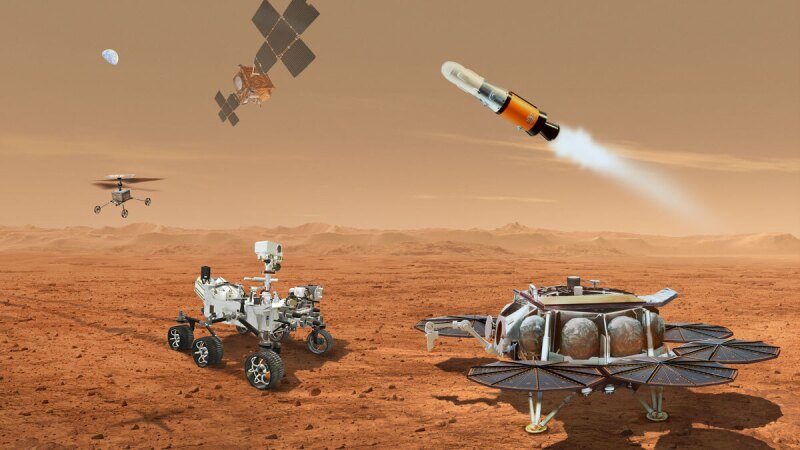When oil and gas industry research efforts slowed down as a result of the COVID-19 pandemic it forced many in academia to look for new ways to diversify their own research portfolios. For some, that meant delving deeper into the topics of climate science and carbon management.
For Mehdi Mokhtari it also created an opportunity to use the earth sciences born from oil and gas research to help explore another world.
The associate professor at the petroleum engineering department of the University of Louisiana at Layfette recently published a study that argues NASA should bring naturally fractured rock samples from Mars back to Earth in a mission planned for next decade.
The rock mechanics expert and longtime space exploration enthusiast said the idea for the study came to him after recalling NASA’s Curiosity rover mission and the images of fractured rocks it sent back.
“There were these dips and wings in the fractures,” he said of the fractures found on the red planet, “and I knew they looked very similar to some of the complex fracture patterns that we see in some unconventional formations. That was very interesting and made me want to see if I could connect what we know here on Earth to what we have seen on Mars.”
But in particular, what Mokhtari and his research team are most focused on are the Mars rocks containing mineral-filled fractures, or veins, which he said represent “clues and evidence about the past presence of water on Mars which is, of course, a big question NASA is trying to answer.”
In 2012, Curiosity landed at a site known as the Gale Crater where it analyzed the minerology of Mars rocks using a tool called the “ChemCam.” The laser-spectrograph technology confirmed that some of the fractured rocks are filled with calcium sulfate, known to most as gypsum.
On Earth, we know that such mineralization often postdates the host rock’s fracture formation by millions of years. If such learnings can be confirmed by analyzing fractures on Mars, then it would help us understand the role water played in its ancient history—and maybe where most of it went.
One of the places Mokhtari and others are turning to in the meantime is Utah where mudstone outcrops are believed to closely resemble the fractured rocks found in recent years on Mars.

What the team from the University of Louisiana at Lafayette is doing differently is using digital image correlation (DIC) to study the fractures and veins found in the Utah outcrops to suggest how they might have formed. The university research team pioneered the use of DIC for studying hydraulic fracture propagation several years ago.
Their new hope is to influence the latest mission on Mars which involves the Perseverance rover that landed in 2020 at the Jezero Crater. The site was chosen because it is believed that at one point eons ago it held a large lake which might have hosted life.
However, the lake eventually dried up which is why some think the fractures found around the crater are really leftover desiccation cracks. Mokhtari said this theory has gained traction because so many of the fractures in the area exhibit the polygonal shape that is distinctive of the desiccation cracks that we see in dry lakebeds on this planet.
Others believe the fractures were created by tectonics, thermal shifts, or even hydraulically due to hydrostatic pressure. “Just like the process we use known as hydraulic fracturing, this is similar except it comes from the formation itself,” explained Mokhtari of the latter theory.
But the key is that we may not know any of this for sure until some of these rocks are in the hands of scientists and researchers. That day is expected to come next decade thanks to NASA’s proposed Mars Sample Return (MSR) mission.

The goal of the MSR mission is to send a spacecraft to Mars by 2028 where samples collected by Perseverance will be loaded up and then rocketed back to Earth by 2033. The idea gained some precedent just this month after NASA’s OSIRIS-Rex successfully dropped to Earth what were described as “pristine samples” collected from the surface of a nearby asteroid.
Mokhtari said if NASA decides to return some fractured rock during the MSR mission, it will need the help of oil and gas experts who understand rock mechanics and how it relates to retrieving and preserving samples.
"It will be a delicate project because these kinds of rocks—ones with veins—have a tensile strength that is one-third that of a fully intact sample," he said. In other words, these valuable samples might fall apart either while taken or while in transit to their new planet.
Mokhtari said the good news is that the oil and gas industry and its academic wings have decades of experience in this matter.
“My goal here is to link what NASA is doing on Mars with what we can do in petroleum engineering,” he said. “They have a lot of good geologists and can make rovers, but we also know a lot about how to take samples and have a deep understanding of natural fractures.”
For Further Reading:
Icarus 115760 Mechanical Properties of Terrestrial Analogs to Calcium Sulfate Veins on Gale Crater, Mars by Ali Ettehadi, Mehdi Mokhtari, Maksym Chuprin, University of Louisiana at Lafayette, et al.


